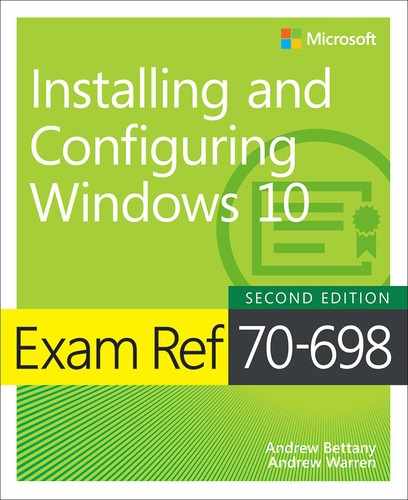Contents
Quick access to online references
Errata, updates, & book support
Skill 1.1: Prepare for installation requirements
Determine hardware requirements and compatibility
Choose an upgrade or a clean installation
Determine editions by device type
Determine requirements for particular features
Identify a strategy and prepare the installation media
Upgrade using installation media
Configure native boot scenarios
Migrate from previous versions of Windows
Install additional Windows features
Configure Windows for additional regional and language support
Skill 1.3: Configure devices and device drivers
Update, disable, and roll back drivers
Use Deployment Image Servicing And Management tool to add packages
Skill 1.4: Post-installation configuration
Configure and customize the user interface per device type
Configure accessibility options
Skill 1.5: Implement Windows in an enterprise environment
Provision with Windows Configuration Designer tool
Configure and optimize User Account Control
Configure Active Directory, including Group Policy
Chapter 2 Configure and support core services
Skill 2.1: Configure networking
Configure and support IPv4 and IPv6 network settings
Configure Windows Firewall, including Advanced Security and Network Discovery
Configure Wi-Fi settings and Wi-Fi Direct
Configure disks, volumes, and file systems
Create and configure virtual hard disks
Create and configure Storage Spaces
Troubleshoot storage issues and removable devices
Skill 2.3: Configure data access and usage
Configure file and printer sharing
Configure HomeGroup connections
Configure File System permissions
Troubleshoot data access and usage
Implement Microsoft Store Apps
Create and deploy provisioning packages
Skill 2.5: Configure remote management
Choose the appropriate remote management tools
Configure remote management settings
Configure Windows PowerShell remoting
Modify settings, using Microsoft Management Console or Windows PowerShell
Chapter 3 Manage and maintain Windows
Configure Windows Update options
Current Branch and Current Branch for Business
Long-Term Servicing Branch scenarios
Configure and analyze Event Viewer logs
Monitor performance using Task Manager
Monitor performance using Resource Monitor
Monitor performance using Performance Monitor and Data Collector Sets
Manage client security by using Windows Defender Security Center
Evaluate system stability by using Reliability Monitor
Troubleshoot performance issues
Skill 3.3: Configure system and data recovery
Perform recovery operations using Windows Recovery
Use Windows Backup And Restore
Perform a backup and restore with WBAdmin
Restore previous versions of files and folders
Skill 3.4: Configure authorization and authentication
Configure User Account Control behavior
Configure Microsoft Passport and Windows Hello for Business
Configure HomeGroup, workgroup, and domain settings
Skill 3.5: Configure advanced management tools
Configure automation of management tasks with Windows PowerShell
Convert Group Policy objects to MDM policies using the MDM Migration Analysis tool
